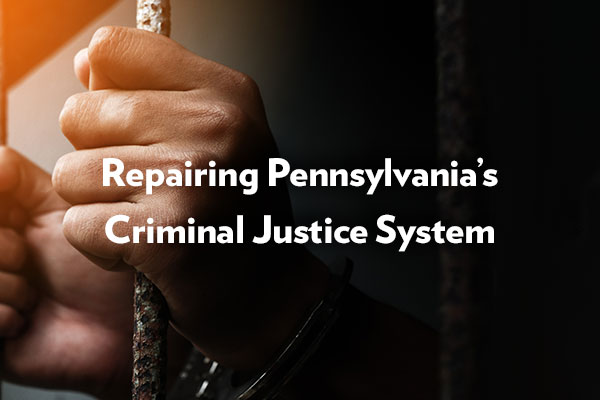Fact Sheet

How Pa. Can Keep Prisons and Communities Safe During Coronavirus
Pennsylvania’s prisons and jails—which house a high population of elderly and coronavirus-risk individuals in close quarters—are particularly vulnerable to the quick spread of COVID-19. Inmates and correctional staff have begun to test positive, making it crucial to mitigate the spread of the novel coronavirus through medical best practices and expedited, reasonable inmate release—ultimately protecting local communities. Here are several recommendations for mitigating the risk of COVID-19 in our corrections system while protecting public safety.
Recommendations to the Legislature
- Expedite parole through emergency legislation.
- The current vacancy on the parole board must be quickly filled, and lawmakers should pass a permanent solution that ensures future vacancies are promptly addressed. Prison populations can then be reasonably reduced during the COVID-19 crisis by completing paroles already in process.
- Temporarily expand parole eligibility to automatically begin the parole process for prisoners 65 and older and those whose sentences have six months or less remaining.
- Provide a directive to the Board of Pardons to expedite commutation hearings for prepared applicants and to finalize pending or deferred cases.
- Given the risk of infection, temporarily cease requiring halfway houses for re-entry while a stay-at-home order is underway.
- Additionally, temporarily waive the requirement for routine check-ins or overnight stays at halfway houses for individuals with commuted sentences.
- Each potential inmate transfer or release should weigh whether that prisoner’s health, or the health of the community, will be in greater risk with release, with such considerations built into the re-entry plan.
Operational Recommendations to the Department of Corrections and Parole Board
- Aligning with U.S. Attorney General Barr’s March 26 memo to the Bureau of Prisons, consider expanding temporary home confinement, particularly for older prisoners who have served much of their sentences and don’t pose a public threat, and those who have a heightened risk of contracting COVID-19.
- Home confinement can include the use of ankle monitoring and GPS tracking.
- Fully implement the provisions in the Justice Reinvestment Initiative 2 (passed December 2019) providing automatic parole for low-level offenders.
- To ensure accountability, require medical officers for each state and county prison to submit and/or publicize their individual disease prevention plans.
- Empower parole officers with the discretion to include remote supervision of parolees.
- Continue best practices and increase health care access and efficiency, including:
- Increased sanitation resources,
- Elimination of copays,
- Increased use of telemedicine,
- Public health education in prisons,
- Mass testing and screening of new prisoners,
- Cell quarantine and food delivery,
- Restriction of visitation.
Best Practice Recommendations to County Officials
- State prisons have a static population and need less emergency attention. However, county-operated jails experience significant “jail churn” in which low-risk, short-sentence, pre-trial, and probation technical violators are more likely to spread COIVD-19. Limiting their population by temporarily decreasing pre-trial detention will mitigate the spread of disease and make room for individuals requiring incarceration.
- Consider temporarily waiving cash bail for non-violent offenders.
- Account for community and disease risk when considering releasing individuals from jail.
- Increase health care access and efficiency, as applicable, from the list above.
- Expand or continue to provide virtual arraignments and attorney access.
- Reduce prison populations where possible through home confinement of elderly inmates.